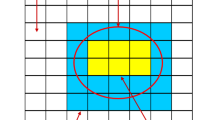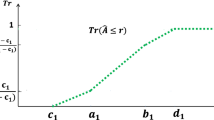Abstract
In these days, rough set theory has emerged as an invaluable tool for expressing uncertainty in various optimization problems as it takes into account both the consistency and the expertise of all the involved experts and thus leads to more realistic decisions. In view of this characteristic of the rough set theory, in this study, a fractional transportation problem in rough environment is investigated which is of great benefit because of being able to study the relative efficiency in various fields such as transportation, resource allocation, information theory, education, administration, etc. In particular, for many real-life transportation problems the objective may be interpreted as the ratio of physical and economic values, such as profit/cost, delivery speed/wastage, actual cost/standard cost, actual time/standard time, etc. A new methodology has been developed to solve the multi-objective fractional transportation problem with rough parameters in which, firstly, the problem is decomposed into two sub-models namely, the upper interval model and the lower interval model. Then the upper interval model is decomposed into two crisp fractional transportation problems to characterize the possibly Pareto-optimal solution and the lower interval model is decomposed into two crisp fractional transportation problems to characterize the surely Pareto-optimal solution, respectively. The proposed methodology incorporates the variable transformation method to address the non-linearity of the objective functions. Thereafter, the Pareto-optimal solution of the linearized model is obtained by using the weighted-sum method. The proposed approach provides a wide range for the obtained optimal compromise solution and allows the decision-maker to choose the best one as per the practical uses. At last, a case study is solved to demonstrate the applicability of the proposed methodology.



Similar content being viewed by others
Data availability
Data available within the article or its supplementary materials.
References
Agrawal P, Ganesh T (2020) Fuzzy fractional stochastic transportation problem involving exponential distribution. Opsearch 57:1093–1114
Ahmed MM, Khan AR, Uddin MS, Ahmed F (2016) A new approach to solve transportation problems. Open J Optim 5(1):22–30
Amaliah B, Fatichah C, Suryani E (2022) A new heuristic method of finding the initial basic feasible solution to solve the transportation problem. J King Saud Univ Comput Inf Sci 34(5):2298–2307
Amaliah B, Fatichah C, Suryani E (2022) A supply selection method for better feasible solution of balanced transportation problem. Expert Syst Appl 203:117399
Anukokila P, Radhakrishnan B (2019) Goal programming approach to fully fuzzy fractional transportation problem. J Taibah Univ Sci 13(1):864–874
Arabani M (2006) Application of rough set theory as a new approach to simplify dams location. Sci Iran 13(2):152–158
Arya R, Singh P, Kumari S, Obaidat MS (2020) An approach for solving fully fuzzy multi-objective linear fractional optimization problems. Soft Comput 24(12):9105–9119
Atanassov K (1986) Intuitionistic fuzzy sets. Fuzzy Sets Syst 20(1):87–96
Bagheri M, Ebrahimnejad A, Razavyan S, Lotfi FH, Malekmohammadi N (2020) Fuzzy arithmetic DEA approach for fuzzy multi-objective transportation problem. Oper Res Int J 22:1479–1509
Bera RK, Mondal SK (2020) Credit linked two-stage multi-objective transportation problem in rough and bi-rough environments. Soft Comput 24(23):18129–18154
Bera S, Giri PK, Jana DK, Basu K, Maiti M (2018) Multi-item 4D-TPs under budget constraint using rough interval. Appl Soft Comput 71:364–385
Bharati SK (2019) Trapezoidal intuitionistic fuzzy fractional transportation problem. Soft computing for problem solving. Springer, Berlin, pp 833–842
Bhatia TK, Kumar A, Sharma MK (2022) Mehar approach to solve fuzzy linear fractional transportation problems. Soft Comput 20:1–27
Bouzayane S, Saad I (2020) A multi-criteria approach based on rough set theory for the incremental periodic prediction. Eur J Oper Res 286(1):282–298
Chakraborty M, Gupta S (2002) Fuzzy mathematical programming for multi objective linear fractional programming problem. Fuzzy Sets Syst 125(3):335–342
Charnes A, Cooper WW (1962) Programming with linear fractional functionals. Naval Res Logist Q 9(3):181–186
Dantzig GB, Thapa MN (2006) Linear programming 2: theory and extensions. Springer, Berlin
El Sayed M, Abo-Sinna MA (2021) A novel approach for fully intuitionistic fuzzy multi-objective fractional transportation problem. Alex Eng J 60(1):1447–1463
Garg H, Rizk-Allah RM (2021) A novel approach for solving rough multi-objective transportation problem: development and prospects. Comput Appl Math 40(4):1–24
Garg H, Mahmoodirad A, Niroomand S (2021) Fractional two-stage transshipment problem under uncertainty: application of the extension principle approach. Complex Intell Syst 7(2):807–822
Ghosh S, Roy SK (2021) Fuzzy-rough multi-objective product blending fixed-charge transportation problem with truck load constraints through transfer station. RAIRO-Oper Res 55:2923–2952
Ghosh S, Roy SK, Fugenschuh A (2022) The multi-objective solid transportation problem with preservation technology using pythagorean fuzzy sets. Int J Fuzzy Syst 24(6):2687–2704
Giri BK, Roy SK (2022) Neutrosophic multi-objective green four-dimensional fixed-charge transportation problem. Int J Mach Learn Cybern 13(10):3089–3112
Gupta A, Khanna S, Puri M (1993) A paradox in linear fractional transportation problems with mixed constraints. Optimization 27(4):375–387
Gupta S, Garg H, Chaudhary S (2020) Parameter estimation and optimization of multi-objective capacitated stochastic transportation problem for gamma distribution. Complex Intell Syst 6(3):651–667
Hitchcock FL (1941) The distribution of a product from several sources to numerous localities. J Math Phys 20(1):224–230
Javaid S, Jalil SA, Asim Z (2017) A model for uncertain multi-objective transportation problem with fractional objectives. Int J Oper Res 14(1):11–25
Joshi VD, Gupta N (2011) Linear fractional transportation problem with varying demand and supply. Matematiche (Catania) 66(2):3–12
Karagul K, Sahin Y (2020) A novel approximation method to obtain initial basic feasible solution of transportation problem. J King Saud Uni Eng Sci 32(3):211–218
Khalifa HAEW, Kumar P, Alharbi MG (2021) On characterizing solution for multi-objective fractional two-stage solid transportation problem under fuzzy environment. J Intell Syst 30(1):620–635
Khurana A, Arora S (2006) The sum of a linear and a linear fractional transportation problem with restricted and enhanced flow. J Interdiscip Math 9(2):373–383
Liu B (2009) Theory and practice of uncertain programming, vol 239. Springer, Berlin
Liu ST (2016) Fractional transportation problem with fuzzy parameters. Soft Comput 20(9):3629–3636
Mahmoodirad A, Dehghan R, Niroomand S (2019) Modelling linear fractional transportation problem in belief degree-based uncertain environment. J Exp Theoret Artif Intell 31(3):393–408
Mardanya D, Roy SK (2022) Time variant multi-objective linear fractional interval-valued transportation problem. Appl Math A J Chin Univ 37(1):111–130
Mardanya D, Maity G, Kumar Roy S (2022) The multi-objective multi-item just-in-time transportation problem. Optimization 71(16):4665–4696
Midya S, Roy SK (2020) Multi-objective fixed-charge transportation problem using rough programming. Int J Oper Res 37(3):377–395
Midya S, Roy SK, Weber GW (2021) Fuzzy multiple objective fractional optimization in rough approximation and its aptness to the fixed-charge transportation problem. RAIRO Oper Res 55(3):1715–1741
Naouali S, Salem SB, Chtourou Z (2020) Uncertainty mode selection in categorical clustering using the rough set theory. Expert Syst Appl 158:113555
Pawlak Z (1982) Rough sets. Int J Comput Inf Sci 11(5):341–356
Rebolledo M (2006) Rough intervals enhancing intervals for qualitative modeling of technical systems. Artif Intell 170(8):667–685
Roy SK, Midya S, Weber GW (2019) Multi-objective multi-item fixed-charge solid transportation problem under twofold uncertainty. Neural Comput Appl 31(12):8593–8613
Sadia S, Gupta N, Ali QM (2016) Multi-objective capacitated fractional transportation problem with mixed constraints. Math Sci Lett 5(3):235–242
Saini R, Joshi VD, Singh J (2022) On solving a MFL paradox in linear plus linear fractional multi-objective transportation problem using fuzzy approach. Int J Appl Comput Math 8(2):1–13
Sharma HK, Kumari K, Kar S (2020) A rough set theory application in forecasting models. Decis Mak Appl Manage Eng 3(2):1–21
Sharma MK, Dhiman N, Kamini, Mishra VN, Rosales HG, Dhaka A, Nandal A, Fernandez EG, Ramirez delReal TA, Mishra LN (2021) A fuzzy optimization technique for multi-objective aspirational level fractional transportation problem. Symmetry 13(8):1465
Shivani, Rani D, Ebrahimnejad A (2022) An approach to solve an unbalanced fully rough multi-objective fixed-charge transportation problem. Comput Appl Math 41(4):129
Stankovic M, Gladovic P, Popovic V (2019) Determining the importance of the criteria of traffic accessibility using fuzzy AHP and rough AHP method. Decis Mak Appl Manage Eng 2(1):86–104
Swarup K (1966) Transportation technique in linear fractional functional programming. J R Naval Sci Serv 21(5):256–260
Tao Z, Xu J (2012) A class of rough multiple objective programming and its application to solid transportation problem. Inf Sci 188:215–235
Veeramani C, Edalatpanah S, Sharanya S (2021) Solving the multiobjective fractional transportation problem through the neutrosophic goal programming approach. Discret Dyn Nat Soc 20:21
Velazquez Rodriguez JL, Villuendas Rey Y, Yanez Marquez C, Lopez Yanez I, Camacho Nieto O (2020) Granulation in rough set theory: a novel perspective. Int J Approx Reason 124:27–39
Xu J, Tao Z (2011) Rough multiple objective decision making. CRC Press, New York
Zadeh L (1963) Optimality and non-scalar-valued performance criteria. IEEE Trans Autom Control 8(1):59–60
Zadeh L (1965) Fuzzy sets. Inf Control 8(3):338–353
Zhao J, Liang JM, Dong ZN, Tang DY, Liu Z (2020) Accelerating information entropy-based feature selection using rough set theory with classified nested equivalence classes. Pattern Recogn 107:107517
Acknowledgements
The first author is thankful to the Ministry of Human Resource Development, India, for providing financial support to carry out this work. The authors would also like to thank the anonymous reviewers and the associate editor for their insightful comments and suggestions.
Author information
Authors and Affiliations
Corresponding author
Ethics declarations
Conflict of interest
All the authors declare that they have no conflict of interest.
Ethical approval
This article does not contain any studies with human participants or animals performed by any of the authors.
Additional information
Publisher's Note
Springer Nature remains neutral with regard to jurisdictional claims in published maps and institutional affiliations.
Rights and permissions
Springer Nature or its licensor (e.g. a society or other partner) holds exclusive rights to this article under a publishing agreement with the author(s) or other rightsholder(s); author self-archiving of the accepted manuscript version of this article is solely governed by the terms of such publishing agreement and applicable law.
About this article
Cite this article
Shivani, Rani, D. & Ebrahimnejad, A. On solving fully rough multi-objective fractional transportation problem: development and prospects. Comp. Appl. Math. 42, 266 (2023). https://doi.org/10.1007/s40314-023-02400-z
Received:
Revised:
Accepted:
Published:
DOI: https://doi.org/10.1007/s40314-023-02400-z
Keywords
- Multi-objective optimization
- Fractional transportation problem
- Rough interval
- Weighted-sum method
- Pareto-optimal solution




